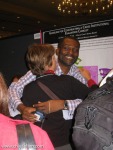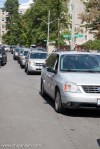If you attend any social events these days, be it a wedding, a business meeting, or a birthday party, chances are someone will be photographing the event. Learning how to be photographed as an attendee and how to be comfortable in front of a camera goes a long way both personally and professionally. You’ll help to ensure that the most flattering ‘you’ is captured, and this, in turn, will ensure that you’ll have one kick-ass image that you could use for your own blog, Facebook, or portfolio! As an event photographer, I have shot thousands of images of folks attending social events. Let me give you 11 insider tips on how to be photographed at a social event.
Professional photographers are best at making attendees feel comfortable. But they can be the most intimidating with their professional gear. Professional photographers are there to capture the best of the event: the atmosphere, the decorations, the attendees, their interactions, and the “buzz” of the event. A skilled professional photographer knows how to shoot an event without being intrusive. A skilled photographer makes his/her presence known in order to help his subjects feel at ease. The professional photographer will try to stay stealthy. While you may not know when a photographer may photograph you, do know that photographers only want to publish the best of you.
11. When in doubt, relax and smile. Enjoy yourself.
10. When spotted by the photographer, keep doing what you’re doing, unless otherwise instructed. There’s no need to suddenly stop and smile for the camera. The photographer is often interested in candid shots of people mingling, interacting, and generally having a good time. If you know you’re being photographed doing something, it does help if you slow your action by just a tad. If you would prefer to not be photographed, simply smile and wave no.
9. Act like you’re interested in your companions, even if you’re not.
8. Tyra Banks knows how it’s done: smize. Smile and let your eyes sparkle, especially when you’re talking to someone else. Photographers want to see life and engagement in your eyes.
7. When being photographed in a group shot (you know those elementary school class photos where everybody stands in rows), don’t leave a gaping hole between you and the next person. Stand close, shoulder-to-shoulder, and stand tall. Stand on both feet. Smile.
6. If a photographer raises a lens at you, it’s because he noticed you doing something interesting or photo-worthy. The photographer will likely stay on you for a few seconds, snapping consecutive shots, hoping one might work out. So, keep on doing whatever you were doing.
5. If there’s a speaker speaking at the event, try to stand/sit close to the speaker. Don’t be the odd one lingering at the back of the room.
4. If you’re being photographed chatting in a small group (the “huddle shots”), make sure you’re looking at the speaker. You don’t want to be the odd one out looking disinterested. If you’re chatting with another person (2-person shot), try to stand shoulder-to-shoulder (and not facing each other). This opens up a space for the photographer to get in and photograph the two of you chatting.
3. Don’t track the photographer at an event. Don’t start looking for where he/she is.
2. Photographers have no interest in photographing you eating. Don’t worry. Do not stuff your face full of food if you want to be photographed. If an event serves food, carry your plate near your belly level and not at the chest level. No body wants to see a plate of sandwich.
1. Photographers love animated speakers. When you’re gesturing, keep it hands above your waistline but below your chin. Do not let your hands block your face or eyes. Do what conductors do—they work within an imaginary box that’s above the waist, below the chin, and extends left-and-right. Never crisscross your arms.
Above all, have trust in your photographers. They’re there to make you look good! Be gentle and kind to the photographer. His goal is to bring out the best of you and highlight how awesome the event was.



















































